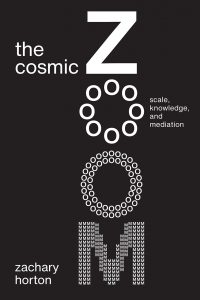An Intro to Cosmic Zoom Media: A Watchlist from Zachary Horton
Negotiating differences in scale can be, to say the least, a complex undertaking—from the minuscule and microscopic to the vastness of human populations to the magnificent size of the space beyond our home planet. In his book The Cosmic Zoom: Scale, Knowledge, and Mediation, Zachary Horton considers the “cosmic zoom,” a trope that has influenced media forms for decades, and he uses this as a starting point to develop a cross-disciplinary theory of scale. Here, he gives us an intro to cosmic zoom media through a watchlist of seven films.
The cosmic zoom, a media form that aestheticizes continuity across a wide range of scales, is ubiquitous today. It is used to evoke wonder at the cosmos, celebrate scientific knowledge and practice, render radically alien scales accessible to humans, paper over differences between scales, and re-center the human observer in physical and medial environments that seem to be slipping (scaling) out of our control. Though cosmic zooms are not always visual, their most mesmeric versions have often been in time-based media. Here are seven cosmic zooms that exemplify the form:
Eva Szasz, Cosmic Zoom, 1968
Canadian artist Eva Szasz adapted Dutch educator Kees Boeke’s 1957 book, Cosmic View, into this delightful animation a decade later. While Boeke’s book reproduced a different scale on each page, emphasizing the breaks or “jumps” between them, Szasz emphasized spatial continuity through animation, employing the technology of the animation stand to continually “zoom” in on a series of drawings. Analyzing these moves through the concept of resolution, however, reveals a discrepancy between the aesthetic of the zoom and the ontological and medial discreteness of the layers in play.
Ray and Charles Eames, Rough Sketch, 1968
Iconic modernist designers and married collaborators Ray and Charles Eames produced their own adaptation of Cosmic View in the same year as Szasz. Their ambitious production combined live-action filmmaking with photography and drawings to attempt a photo-realistic zoom from the expanse of the known universe to the nucleus of a carbon atom. The film serves as a primer on Relativistic temporality, evoking Einstein’s famous “twin paradox” in its narrative and visualizing diverging clocks for the traveler whose perspective we inhabit as viewers and the picnickers that open the film. Perhaps the most honest cosmic zoom ever produced, Rough Sketch attempts to demonstrate the tradeoff between space and time that is required to feign continuity between scales. Even this film, however, found itself straining the laws of physics, a hotly debated topic behind the scenes between various designers and scientific advisors on the production team.
Ray and Charles Eames, Powers of Ten, 1977
The most iconic cosmic zoom of the 20th century, and perhaps the most influential science film ever released, Powers of Ten was an IBM-funded remake of Rough Sketch that perfected the analog illusion of scalar continuity. For this version, the Eames team brought on board popular science writers and early SETI (Search For Extraterrestrial Intelligence) organizers Philip and Phylis Morrison. The result was a series of internal conflicts over which scales were more important than others, how each should be represented, and the degree of fidelity to reality the film should exhibit. A reading of these conflicts reveals how scalar politics emerge from questions of representation and the strategic collapse of scalar difference. Ultimately, the final film became an amalgam of the sensibilities of the Eameses and Morrisons, a deeply compromised version that, ironically, conveyed to its viewers a sense that all scales were equally close to, accessible to, and masterable by human knowledge. Philip Morrison in particular would later get his philosophical revenge by remediating the film’s images into a 1982 book by the same name that produced a radically different meaning in the gaps.
Bayley Silleck, Cosmic Voyage, 1996
Produced using the most advanced digital tools available to filmmakers in the 1990s, combined with a massive astronomy database, Cosmic Voyage features long sequences of digital zooms. Though Morgan Freeman’s narration makes it clear that this is a film celebrating science and optical technology, the film is most revealing in its use of the twin tools of digital media: the pixel and the database. While the pixel is a technology of sameness, of universality, the database is a technology of difference, of specificity. Cosmic Voyage begins to stage a medial conflict that lies at the core of our contemporary media ecology.
Eames Demetrios, Powers of Ten Interactive, 1999
This interactive CD-ROM, a passion project by Charles Eames’ grandson, is perhaps the most gonzo version of the Eames-derived cosmic zooms. A mashup of hypertext and the CD-ROM encyclopedia—two popular forms of digital textuality in the 1990s, it links a dizzying array of text, images, and video clips together through an interface so cluttered as to be unnavigable (or hypernavigable: you can’t stop jumping from scale to scale, even if you have little control over where you end up). Intentionally or not, this software generates a rhizomatic structure where nearly every scale is linked to nearly every other one. By subverting the smooth continuities of filmic versions of the cosmic zoom and emphasizing a multi-directional, network-based structure, this cosmic zoom provides a generative model of the relationship between scale, environment, and media.
Oliver Stone, Snowden, 2016

A striking cosmic zoom at the halfway point of this feature film perfectly visualizes both the scale of contemporary surveillance media and its database logic. The rhizomatic network structure explored in Powers of Ten Interactive here becomes a dystopian topology of the individual enrolled in structures of identity and governmentality outside of their control or even knowledge. A lesson in the trans-scalar logics of the database, Stone’s zoom progresses from the individual to a population united only by database relations to an abstract planetary body of data to a human eye. Here the collapse of scalar difference is contextualized as a form of governmentality mediated by the database. Caught almost as an afterthought in these surveillance webs is the individual, dis-aggregated as a continuum of consciousness (memory) at a local scale and recomposed through a different kind of memory: digital, multiscalar, and recursive.
Luc Besson, Lucy (2016)

Released the same year as Snowden, Lucy’s climactic sequence is composed of several dramatic cosmic zooms that range through both space and time, from cellular division to the formation of planets to the construction of Manhattan. These recursive zooms, like the others above, pass through and beyond the human body. Like Snowden’s cosmic zoom, these explicitly interrogate the scalar aporias of identity in the database age, as information storage and transmission, along with the compositional nature of the database query, come to address and determine the coordinates of identity in mediated ecologies. Lucy, however, manages to harness this decidedly non-human and multiscalar force, not to re-establish her subjective narrative unity in the face of cosmic chaos, but rather to embrace new forms of multi-scalar and posthuman becoming. Among other scalar innovations, this sequence presents a planet-scale ovum, intergalactic fertilization, and a literal becoming-database in a choreographed fusion of analog and digital scalar dynamics. This cosmic zoom invites us to reflect on one of the central paradoxes of scale: humans construct individual scales and their constellations in order to discipline their knowledge-making and contain the cosmos, yet every act of medial resolution reveals non-human potential through scalar difference that disrupts those tightly controlled schemas. In other words, we make scales, while scale unmakes us.
Zachary Horton is assistant professor of English and media studies at the University of Pittsburgh. He is a game designer, filmmaker, camera designer, and founding director of the Vibrant Media Lab.
The Cosmic Zoom is available now on our website or from your favorite bookseller.
